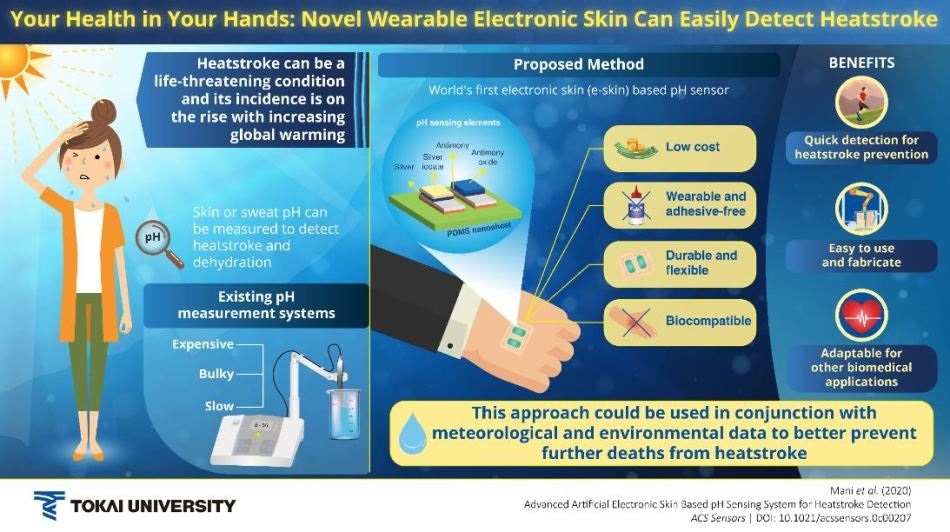Heatstroke is a life-threatening condition that is becoming increasingly common worldwide because of global warming. In a new study, researchers from Tokai University, Japan describe their latest development: a low-cost electronic skin-like sensor that can measure the pH (acidity) of the skin, allowing for early heatstroke detection. Because heatstroke is sometimes asymptomatic, this technology can help people beat the heat, and could also save lives worldwide.

During intense physical exercise or even when idle during hotter days, the human body sometimes finds it difficult to downregulate its temperature, and a rise in temperature above 40 °C results in what is called a heatstroke. Although children and elderly people are the most vulnerable to heatstroke. Heatstroke is sometimes asymptomatic and therefore hard to detect in real time. Unfortunately, climate change is causing more frequent and severe heatwaves worldwide each year. In Japan, the Ministry of the Environment provides regular updates on their heatstroke prevention information site in the form of a “heat index,” but regardless, the number of deaths due to heatstroke keeps increasing.
One method for the early detection of heatstroke is measuring the pH (a measure of acidity or alkalinity) of the skin or sweat, which significantly changes as the body dehydrates. But, existing devices for measuring skin or sweat pH are expensive, non-portable, or inconvenient for a variety of reasons. Current skin pH measurement techniques require a long testing period, rigid electronics, and a high number of sweat samples, making it tough to measure the pH of the skin directly. Monitoring skin pH levels “on the go” is of also great interest to reveal real-time body conditions. This has pushed researchers in various engineering fields to attempt to develop novel approaches.
In a recent study published in ACS Sensors, scientists from Tokai University, Japan, led by Dr Ganesh Kumar Mani, created a new type of skin pH sensor that adheres to the skin without using any type of adhesive.
The key to our invention lies in its base material: it is an ultra-flexible polymer thin film made up of polydimethylsiloxane (PDMS), a flexible and durable material on which the other parts of the sensor electrodes can be placed using high quality deposition processes.”
Dr Ganesh Kumar Mani, Scientists at Tokai University, Japan
The other components of the pH sensor are two small metal electrodes made of silver/silver iodate and antimony/antimony oxide (see the figure below). The idea is that the voltage difference between these two electrodes changes according to the pH of the sweat that accumulates near them, providing a straightforward way of determining sweat pH in real time.
Fig 1. The proposed sweat pH sensor is built on a nanosheet of PDMS, on which two different electrodes are deposited. As shown on the right, the final device conforms easily to the skin and sticks without the need of adhesive, making it a very attractive and practical biosensor.
Not only is the proposed device easy to manufacture at a low cost, it is also extremely lightweight and small, which makes it easier to use for both children and older people without being a hassle. Moreover, a lower final price implies that more people would have access to it regardless of their economic situation, meaning that more lives could be saved.
After testing the durability, flexibility, and sensibility of the novel sensor and finding the results to be very promising, the research team aims to improve the performance of the device with mass production in mind. If many people regularly use sensors that monitor certain bodily parameters, including skin pH, it will be easier for researchers to obtain large-scale data to better understand how environmental factors like temperature and humidity affect bodily parameters when influenced by personal factors such as living environment, race, and age.
In the future, we will combine data from the weather sensor installed at Shonan Campus and from the Japan Meteorological Agency to conduct a multifaceted analysis to demonstrate the relationship among heatstroke, environmental factors, and the pH of sweat.”
Prof. Tsuchiya
Moreover, the novel PDMS-based platform could also be adapted for other attractive purposes. “We expect the obtained results to have implications in a variety of biomedical fields. The proposed process could be useful for functionalizing PDMS nanosheets with a wide variety of materials for multifunctional applications. This nanosheet pH sensor technology could be the next frontier in personalized skincare technology,” remarks Dr Mani. As of now, the scientists have stated that further improvements to the adhesion of the sensor are being tested, along with detailed animal studies.
Source:
Journal reference:
Mani, G.K., et al. (2020) Advanced Artificial Electronic Skin Based pH Sensing System for Heatstroke Detection. ACS Sensors. doi.org/10.1021/acssensors.0c00207.